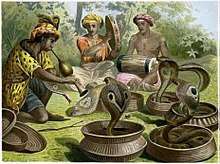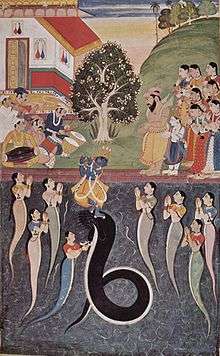Snake charming
Snake charming is the practice of appearing to hypnotize a snake (often a cobra) by playing and waving around an instrument called a pungi. A typical performance may also include handling the snakes or performing other seemingly dangerous acts, as well as other street performance staples, like juggling and sleight of hand. The practice was historically the profession of some tribesmen in India but this is no longer the case.[1][2] Snakecharmer performances still happen in other Asian nations such as Pakistan.[3] Bangladesh, Sri Lanka and south-east Asian nations like Thailand, and Malaysia are also home to performers, as are the North African countries of Egypt, Morocco and Tunisia.
Ancient Egypt was home to one form of snake charming, though the practice as it exists today likely arose in India. It eventually spread throughout Southeast Asia, the Middle East, and North Africa. Despite a sort of golden age in the 20th century, snake charming is today slowly dying out. This is due to a variety of factors, chief among them the enforcement of a 1972 law in India banning ownership of snakes. In retaliation, snake charmers have organized in recent years, protesting the loss of their only means of livelihood, and the government has made some overtures to them. Snake charming is almost extinct in India.[4][5].
Many snake charmers live a wandering existence, visiting towns and villages on market days and during festivals. During a performance, snake charmers may take a number of precautions. The charmer typically sits out of biting range and the snake is sluggish and reluctant to attack anyway. More drastic means of protection include removing the reptile's fangs or venom glands, or even sewing the snake's mouth shut. The most popular species are those native to the snake charmer's home region, typically various kinds of cobras, though vipers and other types are also used.
Although snakes are able to sense sound, they lack the outer ear that would enable them to hear the music. They follow the pungi that the "snake charmer" holds with his hands. The snake considers the person and pungi a threat and responds to it as if it were a predator.
History
The earliest evidence for snake charming comes from ancient Egyptian sources. Charmers there mainly acted as magicians and healers. As literate and high-status men, part of their studies involved learning the various types of snake, the gods to whom they were sacred, and how to treat those who were bitten by the reptiles. Entertainment was also part of their repertoire, and they knew how to handle the animals and charm them for their patrons.
One of the earliest records of snake charming appears in the Bible in Psalm 58:3–5: "The wicked turn aside from birth; liars go astray as soon as they are born. Their venom is like that of a snake, like a deaf serpent that does not hear, that does not respond to the magicians, or to a skilled snake-charmer."
Snake charming as it exists today probably originated in India.[6] Hinduism has long held serpents to be sacred; the animals are believed to be related to the Nagas, and many gods are pictured under the protection of the cobra.
The earliest snake charmers were likely traditional healers by trade. As part of their training, they learned to treat snake bites. Many also learned how to handle snakes, and people called on them to remove snakes from their homes. Baba Gulabgir (or Gulabgarnath) became their guru since his legend states that he taught people to revere the reptiles and not fear them. The practice eventually spread to nearby regions, ultimately reaching North Africa and Southeast Asia.

The early 20th century proved something of a golden age for snake charmers. Governments promoted the practice to draw tourism, and snake charmers were often sent overseas to perform at cultural festivals and for private patrons. In addition, the charmers provided a valuable source of snake venom for creating antivenins.
Today, cultural changes are threatening the profession of the snake charmer in India. One reason for this is the rise of cable television; nature documentaries have extinguished much of the fear and revulsion once felt toward the animals and thus demystified the snake charmer. Animal-rights groups have also made an impact because of the cruelty of the practice, and the abuse of a number of endangered species. Another factor is urbanisation and deforestation, which have made the snakes upon which the charmers rely increasingly rare.
Perhaps the most important reason snake charming is declining in India is that it is no longer legal[7] following changes to the Wildlife Protection Act. The law was originally passed in 1972, and aimed at preventing the export of snakeskins, introducing a seven-year prison term for owning or selling snakes.[8] Beginning in the late 1990s, however, the law was also applied to the snake charmers. As a result, the charmers were forced to move their performances to less-travelled areas such as small villages or face legal actions. The trade is hardly profitable anymore, and many practitioners must supplement their income by alternative jobs, like working as day labourers. Children of snake charmers increasingly decide to leave the profession to pursue higher-paying work, and many fathers do not try to make them reconsider.
Some snake charmers have struck back against this stereotype. In 2003, hundreds of them gathered at the temple of Charkhi Dadri in Haryana to bring international attention to their plight.[9] In December of the following year, a group of snake charmers stormed the legislature of the Indian state of Odisha with their demands while brandishing their animals. The Indian government and various animal-rights groups have now acknowledged the problem. One suggested solution is to train the performers to be snake handlers, capturing and removing venomous snakes from city and suburban gardens.[10] In return, they could sell their traditional medicines as souvenirs. Another proposal would try to focus attention on the snake charmers' music and treat them like other street musicians.
Performance
Snake charmers typically walk the streets holding their serpents in baskets or pots hanging from a bamboo pole slung over the shoulder. Charmers cover these containers with cloths between performances. Dress in India, Pakistan and neighbouring countries is generally the same: long hair, a white turban, earrings, and necklaces of shells or beads. Once the performer finds a satisfactory location to set up, he sets his pots and baskets about him (often with the help of a team of assistants who may be his apprentices) and sits cross-legged on the ground in front of a closed pot or basket. He removes the lid, then begins playing a flute-like instrument made from a gourd, known as a been or pungi. As if drawn by the tune, a snake eventually emerges from the container; if a cobra, it may even extend its hood.
In the Western world snake charming is very different. Western style snake charmers use pythons and boa constrictors for their performances as they are not venomous. Western style snake charmers do not use a musical instrument, instead they perform dance routines involving the snakes.[11]
Snakes
Traditionally, snake charmers use snakes that they have captured themselves in the wild. This task is not too difficult, as most South Asian and North African snakes tend to be slow movers. The exercise also teaches the hunter how to handle the wild reptiles. Today, however, more and more charmers buy their animals from snake dealers. A typical charmer takes in about seven animals per year.
The exact species of serpents used varies by region. In India, the Indian cobra is preferred, though some charmers may also use Russell's vipers. Indian and Burmese pythons, and even mangrove snakes are also encountered, though they are not as popular. In North Africa, the Egyptian cobra, puff adder, carpet viper and horned desert viper are commonly featured in performances.[12] In The UK, US and Europe pythons and boa constrictors are used to comply with Animal Handling and Animal Welfare Regulations.[11]
Except for the pythons, boa constrictor, and mangrove snakes, all of these species are highly venomous.
Safety measures
At home, snake charmers keep their animals in containers such as baskets, boxes, pots, or sacks.
For safety, some North African snake charmers stitch closed the mouth of their performing snakes, leaving just enough opening for the animal to be able to move its tongue in and out. Members of the audience in that region believe that the snake's ability to deliver venomous bites comes from its tongue, rather than fangs.[12] Snakes subjected to this practice soon die of starvation or mouth infection, and must be replaced by freshly caught specimens.[12] Similar methods are used in India, where snakes are defanged and have their poison sacks incapacitated.[13] They are then also kept in boxes or bags for 30-45 days and dehydrated so that their muscles cramp (making them sluggish) and so that they will drink the milk offered by devotees at festivals (the milk is undigestible to the snake).[14]
Methods of dealing with the fangs include expert surgical removal of both the fangs and replacement fangs, which has been done by some Native American and African snake charmers. Barring extraordinary measures, pulled fangs are replaced within days. Fangs may also be plugged with wax or other material.[15]
In West Africa, charmers have been observed to treat the snake's body and mouth with herbs that paralyze the jaw muscles and cause inflammation of the venom glands.[15]
Members of the Pakkoku clan of Burma tattoo themselves with ink mixed with cobra venom on their upper body in a weekly inoculation which may protect them from the snake, though there is no scientific evidence of that.[15]
Lifestyle
.jpg)
Snake charming is typically an inherited profession. Most would-be charmers thus begin learning the practice at a young age from their fathers. In 2007 a viral video made headlines about an infant who was playing with a defanged cobra.[17] Members of the Sapera or Sapuakela castes, snake charmers have little other choice of profession. In fact, entire settlements of snake charmers and their families exist in some parts of India and neighbouring countries. In Bangladesh, snake charmers are typically members of the nomadic ethnic group Bede. They tend to live by rivers and use them to boat to different towns on market days and during festivals.
North African charmers usually set up in open-air markets and souks for their performances. In coastal resort towns and near major tourist destinations one can see snake charmers catering to the tourist market, but in most of the region they perform for the local audiences; an important part of their income comes from selling pamphlets containing various magic spells (in particular, of course, against snake bites).[12]
In previous eras, snake charming was often the charmer's only source of income. This is less true today, as many charmers also scavenge, scrounge, sell items such as amulets and jewelry, or perform at private parties to make ends meet. Snake charmers are often regarded as traditional healers and magicians, as well, especially in rural areas. These charmers concoct and sell all manner of potions and unguents that purportedly do anything from curing the common cold to raising the dead. They also act as a sort of pest control, as villagers and city-dwellers alike call on them to rid homes of snakes.
- Snake charming in art


- Daniel Hernández Morillo, La charmeuse de serpents, 1881, (Musée des beaux-arts de Dunkerque)
 Paul Trouillebert, The Nude Snake Charmer.
Paul Trouillebert, The Nude Snake Charmer. Étienne Dinet, The snake charmer, 1889 (Art Gallery of New South Wales)
Étienne Dinet, The snake charmer, 1889 (Art Gallery of New South Wales) Antonio Fabres, The Young Snake Charmer
Antonio Fabres, The Young Snake Charmer
See also
- Venomoid
- Snake handling, a religious ritual
- Worm charming
- Snake Shyam
References
- Chandra, Sharmila (12 November 2013). "India's snake-charmers sway on the edge of extinction A traditional art form faces extinction". India Today. Retrieved 16 April 2020.
- Harding, Luke (2 April 2002). "Snake tricks lose their charm". The Guardian. Retrieved 16 April 2020.
- Amtul Jamil (21–27 December 2012), "Snakes and charmers", The Friday Times, XXIV (45). Umerkot is one of the centers of the craft in Pakistan.
- Harding, Luke (2 April 2002). "Snakes tricks lose their charm". The Guardian. Retrieved 16 April 2020.
- Chandra, Sharmila (12 November 2013). "India's snake-charmers sway on the edge of extinction A traditional art form faces extinction". India Today. Retrieved 16 April 2020.
- Powell, Michael; Forbeck, Matt (18 December 2012). The Most Forbidden Knowledge: 151 Things NO ONE Should Know How to Do. Adams Media. ISBN 978-1440560934.
- "India's Snake Charmers Work Around Ban", NPR, 14 July 2004
- "India snake charmers have identity crisis". Los Angeles Times. 21 February 2012. Retrieved 1 February 2020.
- Bezbaruah, Supriya (17 November 2003). "Snake charmers' panchayat demand alternative as govt declare art illegal". India Today. Retrieved 8 July 2020.
- "In India, Snake Charmers Are Losing Their Sway". NPR.org. Retrieved 1 February 2020.
- Patterson, Alice. "Everything You Need To Know About Snake Charming". Oddle Entertainment Agency. Retrieved 1 February 2020.
- Highfield, Andy C. and Bayley, Jane R. "Folklore, Myth, and Exploitation of snakes in Morocco and Tunisia". Tortoisetrust.org. Section "Snakes".
- Frederic Friedel (2016). "The snake charmer's deadly secret".
- "Truth behind Nag Panchami". 2013.
- John C. Murphy (2010). Secrets of the Snake Charmer: Snakes in the 21st Century. iUniverse. ISBN 9781450221276.
- "Serpent Charmers". Wesleyan Juvenile Offering. London: Wesleyan Mission House. XXII: 161. November 1865. Retrieved 1 December 2015.
- "Baby's bizarre 'bite' of passage with cobra". Daily Mail. London. 9 May 2007.
- Reuters (1 December 2000). "animal-rights activists, authorities get tough on snake charmers".
- Bagla, Pallava (23 April 2002). "India's Snake Charmers Fade, Blaming Eco-Laws, TV". National Geographic News.
- Bose, Derek (7 December 2003). "Snake Charmers of India". The Tribute.
- "Charming". 29 December 2004. The Economist.
- Houlihan, Patrick F. (May–June 2003). "Spellbound: Charming the Snake & Scorpion". 3 (6). Ancient Egypt Magazine.
- Lawson, Alastair (6 February 2003). "Snake charmers fight for survival". BBC News.
- Khan, Ali Reza (2012). "Snake Charmer". In Islam, Sirajul; Jamal, Ahmed A. (eds.). Banglapedia: National Encyclopedia of Bangladesh (Second ed.). Asiatic Society of Bangladesh.
- "Snake Charming to Turn Eco-Friendly". (27 June 2004). Herp Digest vol. 4, #42.
- Team CO07974 (2000). "Poisonous Plants and snakes: The Truth behind Snake-Charming". Thinkquest.org.
External links
| Wikimedia Commons has media related to Snake charming. |
- Cobra Snake Hunting & Snake Charmers Performers,Rajasthan
- Snake Chamers Street Performers:Cobra Flute Music
- Rajasthan Snake Charmer Profession
- Cobra Dance at Negombo Beach
- YouTube video showing a Kerala Snake charmer